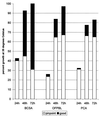Comparison of isolation media for recovery of Burkholderia cepacia complex from respiratory secretions of patients with cystic fibrosis
- PMID: 10074517
- PMCID: PMC88640
- DOI: 10.1128/JCM.37.4.1004-1007.1999
Comparison of isolation media for recovery of Burkholderia cepacia complex from respiratory secretions of patients with cystic fibrosis
Abstract
Burkholderia cepacia selective agar (BCSA) has previously been devised for isolation of B. cepacia from respiratory secretions of patients with cystic fibrosis and tested under research laboratory conditions. Here we describe a study in which BCSA, oxidation-fermentation polymyxin bacitracin lactose agar (OFPBL), and Pseudomonas cepacia agar (PCA) were compared in routine culture procedures for the ability to grow B. cepacia and inhibit other organisms. Three hundred twenty-eight specimens from 209 patients at two pediatric centers and 328 specimens from 109 adults were tested. Plates were inoculated, incubated, and read for quality and quantity of growth at 24, 48, and 72 h. Five (1.5%) specimens from 4 (1.9%) children and 75 (22.9%) specimens from 16 (14.7%) adults grew B. cepacia complex. At 24, 48, and 72 h, BCSA achieved 43, 93, and 100% detection, respectively; OFPBL achieved 26, 84, and 96%, respectively; and PCA achieved 33, 74, and 84% detection, respectively. Quality was assessed as pinpoint or good growth. At 24 h, most cultures growing B. cepacia complex had pinpoint colonies. By 48 and 72 h, 48 and 69% of B. cepacia complex cultures, respectively, had good growth on BCSA, while on OFPBL 19 and 30%, respectively, had good growth and on PCA 11 and 18%, respectively, had good growth. BCSA was superior to OFPBL and PCA in suppressing organisms other than B. cepacia complex; 40 non-B. cepacia complex organisms were isolated from BCSA, 263 were isolated from OFPBL, and 116 were isolated from PCA. We conclude that BCSA is superior to OFPBL and PCA in its ability to support the growth of B. cepacia complex and to suppress other respiratory organisms.
Figures

References
-
- Burdge D R, Noble M A, Campbell M E, Krell V L, Speert D P. Xanthomonas maltophilia misidentified as Pseudomonas cepacia in cultures of sputum from patients with cystic fibrosis: a diagnostic pitfall with major clinical implications. Clin Infect Dis. 1994;20:445–448. - PubMed
-
- Burns J L, Emerson J, Stapp J R, Yim D L, Krzewsinski J, Louden L, Ramsey B W, Clausen C R. Microbiology of sputum from patients at cystic fibrosis centers in the United States. Clin Infect Dis. 1998;27:158–163. - PubMed
-
- Coenye T, Govan J R W, Kersters K, Vandamme P. Proceedings of the 12th North American Cystic Fibrosis Conference. 1998. Automated AFLP analysis for the identification of Burkholderia species and genomovars occurring in CF patients, abstr. 428.
Publication types
MeSH terms
Substances
LinkOut - more resources
Full Text Sources
Medical

